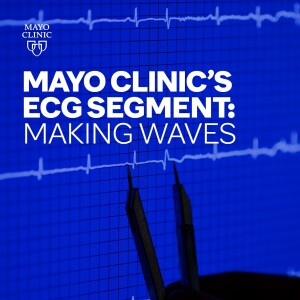
439.8K
Downloads
289
Episodes
The Cardiovascular CME podcast is a free educational offering from Mayo Clinic, featuring content geared towards physicians, physician assistants, and nurse practitioners who are interested in exploring a multitude of cardiology-related topics.
Tune in and subscribe to explore today’s most pressing cardiology topics with your colleagues at Mayo Clinic and gain valuable insights that can be directly applied to your practice.
No CME credit offered for podcast episodes at this time.
Episodes

Tuesday Jul 16, 2024
Understanding ECG Waveforms: Normal vs. Abnormal
Tuesday Jul 16, 2024
Tuesday Jul 16, 2024
Understanding ECG Waveforms: Normal vs. Abnormal
Guest: Dr. Peter van Dam
Host: Anthony H. Kashou, M.D.
The ECG interpretation is majorly driven by event detection, i.e. QRS onset and end, QT time, P wave etc. From these we can determine the normal heart rhythm, and some performance measures, like heart rate etc. The ECG waveforms, however, are much less understood. This is a pity, as ECG waveforms, provide instantaneous information on the electrophysiological and structural function of the heart. In this respect it is interesting to know if there is something like a normal ECG waveform or normal PathECG (CineECG). This latter technique is a vector-based method to estimate the electrical position of a moving vector within the heart. Similar normal distributions can be created to compare to the normal ECGs.
- How can we define a normal ECG waveform? (ECGs from healthy normal people for different age groups, I used about 6000 normal ECGs, correction for heart rate by resampling to standard QT time (400 ms for instance, these ECGs can be used to create a distribution of amplitudes and derived signals (CineECG) to compare an ECG too)
- What is needed for an accurate waveform comparison? (Good baseline correction, not filtering, but baseline correction) What is the onset and end of the P-wave, QRS and T wave?)
- Are normal ECGs waveforms different from abnormal ECG waveforms? (Of course they overlap, describe left bundle branch block, or ischemia, with long QRS or deviating ST segment )
- Did you use this method to classify ECGs as normal or abnormal? (results from our study (manuscript in preparation) that any QRST sequence in an ECG can be classified as abnormal with an accuracy (AUC) of more than 81%. In our study population 15% of the patients had only atrial related abnormal ECGS)
Connect with Mayo Clinic's Cardiovascular Continuing Medical Education online at https://cveducation.mayo.edu or on Twitter @MayoClinicCV and @MayoCVservices.
LinkedIn: Mayo Clinic Cardiovascular Services
Cardiovascular Education App:
The Mayo Clinic Cardiovascular CME App is an innovative educational platform that features cardiology-focused continuing medical education wherever and whenever you need it. Use this app to access other free content and browse upcoming courses. Download it for free in Apple or Google stores today!
No CME credit offered for this episode.
Podcast episode transcript found here.
